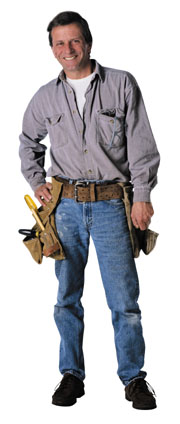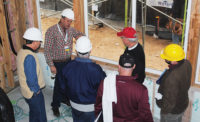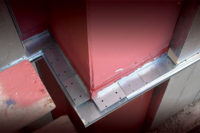
The world is a different place than it was just a couple years ago — deal with it. That seems to be the message we get from insulation contractors these days. It’s not a doom-and-gloom resignation being conveyed in self-pity. It’s “These are the circumstances with which we’re working — let’s go install some insulation!” But what else would we expect from professional insulation contractors?
A custom approach
Prescott, Ariz., home to Advanced Insulation Inc., is a “small community,” explains company president Michael Uniacke. “We’ve grown this company in this community to a level that’s the right size for Prescott right now.”The five-year-old firm currently has 15 employees, but expansion seems inevitable. “We’ll do projects in outlying towns like Flagstaff and Phoenix—not too many right now, but we’ll probably end up doing a lot more. It’s conceivable that we’d open another branch.”
Asked about his niche in the marketplace, Uniacke replies, “Being a growing, yet still small company, we tend to gravitate to the kind of work we’re most successful with, and that’s the higher end of the market.” One contributing factor: “I don’t have the purchasing advantage of my larger competitors.”
Advanced Insulation installs sprayed cellulose on 95 percent of the walls it does. “We’re a big believer in blown-in products due to the inherent quality control,” Uniacke explains.
While Uniacke’s company primarily does custom homes, he adds, in an almost exasperated tone, “There’s so much bad insulation work out there, there’s a lot of retrofit work to be done, too.”
Pressed to explain further, he offers, “Some aspects of the insulation industry, in my view, are borderline dysfunctional. You’ve got the price-conscious consumers beating up the builders and the builders beating up the subs, so the quality gets squeezed out of it when they compete on the merits of low price. As an industry, we sell down, not up. Too often in the residential market, mediocre work is the rule and quality work is the exception.”
The problem in changing that, according to Uniacke: “There’s so much inertia involved. Politically, there are many other issues that have more immediate consequences. And not many politicians and state attorney generals, etc., want to go up against builder groups on this issue. The residential building process is like a form of controlled chaos. Everybody is so squeezed that quality control suffers. And it’s such a multi-disciplinary process for the consumers that they get overwhelmed.”
While he laments that situation as a proud member of the insulation community, his firm’s marketing strategy precludes him from encountering much of that: “We don’t do the tract building; we go after the high end.”
In his experience, Uniacke says, “Owner-builders are more open-minded than builders because they’re going to move into the home. While the builders are thinking about how much profit can be squeezed out of a job, the owner-builders say, ‘I want it done right because I’m going to be living in this house.’ The owner-builders haven’t stopped learning like the builders have. We do things like infrared scanning and walk-throughs with the customer at the end of the job. We try to bring reality as close to the ideal as possible, given the chaotic nature of construction.”
Comparing business this year to 2001, Uniacke says, “Right now, our numbers might be a little down from last year, but by the end of the year, we may well be at the equivalent of last year. It’ll be close. The building in this town is changing,” he explains. “Up until recently, there were more builders who’d build a handful of homes a year. Slowly but surely, things are becoming more like the bigger cities; bigger builders are coming in and starting to build here. Prescott is being discovered. The tri-city area has about 60,000 people. There’s plenty of room and a lot of people are retiring here, which fuels the economy.”
Queried about negative factors impacting his business, Uniacke remarks, “I think the party’s over with our economy; people are being more prudent than they were three or four years ago. We see, in some of the higher-end subdivisions, less building. People who’ve lost a lot of money in the stock market may not be building right now. But aside from that, we’re very busy.”
He adds: “I think finding quality employees always will be a challenge. The challenge specific to insulation contracting is with your lead people. They have to be articulate with customers and they have to be resilient because the work is hard—even doing estimates can be challenging sometimes.”
At Advanced Insulation, they’re looking forward to continued growth in the future. “We typically get the cream the customer who’s truly concerned with quality behind the Sheetrock and has the highest expectations,” Uniacke says. “That’s the minority we’re after because they’re the best customers you can have — the people who want the job done right.”
Balanced attack
Kinzler Construction Services Inc. (KCS) is an 18-year-old firm headquartered in Ames, Iowa, with another office in Des Moines. Company president Kevin Kinzler notes, “While we’re located in central Iowa, we invoiced in nine states last year.”The steadily growing firm has been holding at 65 employees for the past six months or so. “We’ve never had to lay off people,” says Kinzler. “We’re definitely in a growth mode right now. I’ve got a good, young staff that’s working hard and we’re looking to add to that.”
KCS offers a plethora of services; it does residential and all types of commercial insulation installations, as well as fire-stopping, basement waterproofing and closet interiors. That diversity is serving the company well right now.
“We’re seeing a pretty good balance—every category of our business is up this year,” Kinzler reports. “Even on the ag side, which we didn’t think would that would be the case. Right now, we’re doing a lot of confinement-type work in the ag market—hogs, poultry and that kind of stuff—but that probably will taper off soon because of environmental issues. We thought the commercial side would be just OK based on the forecasts we had. The general area here is off just a little, but we’ve been working real hard to take our share or more of what is out there. Overall, I’d rate my geographical market as very strong. Everybody seems to be doing pretty well. While the area may be off a little bit, we’re coming off of several good years in a row. Cheap money is driving a lot of markets. On the residential side, a lot of people now are able to move up from their starter homes.
“We’ve got two or three very good competitors and, of course, some operations that are run out of garages,” Kinzler continues. “And on the larger commercial jobs, out-of-state firms will come in with some really nasty low numbers. But that doesn’t affect us that much in the big picture. It definitely affects the pricing on the particular jobs they’re chasing, which are pretty much isolated down to large multi-family projects.”
With Kinzler’s balance and diversity, the firm is positioned to respond to opportunities as they arise without any gear-up efforts.
Finding quality labor hasn’t been much of a problem for KCS. “It was tougher a year-and-a-half or two years ago,” says Kinzler, “but right now, some of the other trades aren’t as busy. Finding the skilled people is a little more difficult, but we’ve done alright with that.”
Keeping Kinzler out of trouble lately is another manifestation of his firm’s diversity: “I’ve got a metal building insulation system that we invented and developed here and it’s been kickin’ butt. We invented a manifold so we can inject the purlin space on metal buildings. We’ve installed about 400,000 feet of it—and just went public with it last year. We can put an R-45 or so in a 9-inch purlin on a metal building. It’s great for new projects because it gets the guys off the roof quicker; we can insulate from underneath. We do a lot of retrofit with it, too. We’re starting to sell some kits to people and helping them learn how to install it. We may end up with a network of installers. It’s a tremendous opportunity for insulation contractors because people like us haven’t touched metal buildings. We go in and sell the ceiling at $2.50 a foot and end up getting a lot of sidewall work because we’re there. The interesting thing about the new metal buildings going up is the bulk of them are concentrated in 16 or 17 states; you can really chase that market efficiently.”
Kinzler is an ICAA member, as well as a national advisory board member for a major insulation manufacturer. “So I get a lot of good interaction with guys coast-to-coast and that’s helpful to stay tuned into things,” he comments.
KCS is a family business. “Yvonne, my wife, is the office manager and my son, Tanner, is our sales manager,” Kinzler explains. He also has two younger daughters. “It makes it fun with the family involved. In fact, if my son wasn’t interested, I don’t know if I’d still be at it. We’ve got a great business going; I’ve had a couple people come at us to buy us out, but we’re having a good time.”
Arrow deals with it
Barry Pearce is president of Arrow Insulation Co., of Bethany, Okla. The company, started by Pearce and his father in 1981, primarily does residential installations, along with some light commercial work.“On the outside walls, we do the blow-in-blanket, spray foam and occasionally batts,” he explains. “In the attic space, we either blow it with fiberglass or spray it with foam, depending on what the folks want. We probably do 80 percent fiberglass and 20 percent foam.” Retrofitting older homes represents about a quarter of Arrow’s work.
Explaining his firm’s foray into foam, Pearce says, “New homes are being sealed up tighter and tighter every year it seems. That’s why we began spraying the foam—to seal them up even tighter.
“Business has been up and down—even since before Sept. 11,” Pearce says. “It’s been this kind of feast-or-famine way for a couple years—couple days busy, a couple days not. We’ve had to get used to it. During the 1990s, it was pretty much a boom and then things slowed down a bit. We just deal with it and keep moving down the road.”
Regarding Arrow’s competition in the marketplace, Pearce comments, “Other guys are working too cheaply. A look in the telephone book shows that a lot more people seem to think that they’re insulators.”
Pearce knows his customers. “Some builders want a blow-in-blanket job every time; others want the foam every time; still others might want foam walls and fiberglass in the attic—it just depends,” he notes. “But we’ve got it down to where usually we know what exactly they want when they call. More and more of our customers are upgrading to the foam to increase energy efficiency.” The impact on Arrow’s bottom line: “Our profit margin is pretty much the same all the way across.”
Increased interest in sound control is a continuing trend noted by Pearce. “The homeowners are telling the builders that sound control is important to them, so sound control is important to the builder and the insulation contractor.”
Discussing the labor situation, he tells us, “You can’t just hire anyone to come out and spray foam or blow fiberglass the way you want it done. Even if you get some people who’ve insulated before, you still have got to train them to do things the way you want it done. Right now, we have 15 employees and we’re rocking right along.” Back during those boom years of the 1990s, Arrow had 25 employees. After things slowed down, “We kept our very best employees and let go the ones who weren’t the best.”
For a boost to the industry, Pearce says he’d like to see interest rates kept around 6 percent to 7 percent. And he supports energy tax credits on the state and federal levels as an incentive to builders and homeowners to beef up their homes’ insulation levels.
In the short term, Arrow’s president views 2003 as just a continuation of 2001 and 2002—up and down, yet steady overall. “No one is buzzing about any significant changes.” Looking further down the line, he says, “We always will need insulation. And we’re selling more to each house than ever before.” Pearce also points to another wave of baby boom kids on the way. “We’ll be needing more houses—another market to sell to.” W&C


